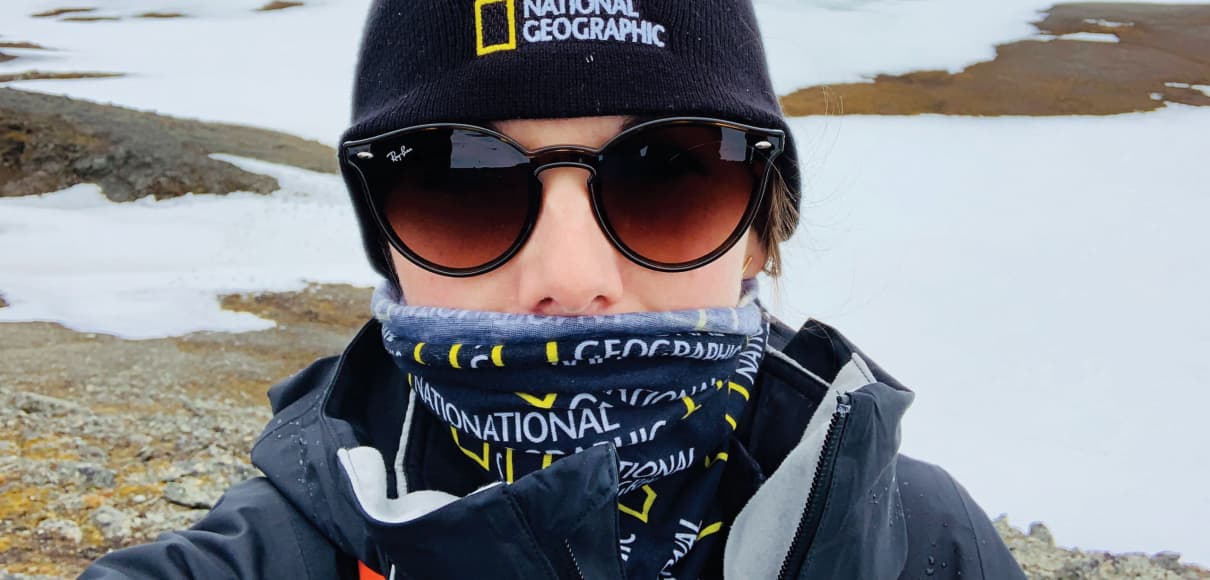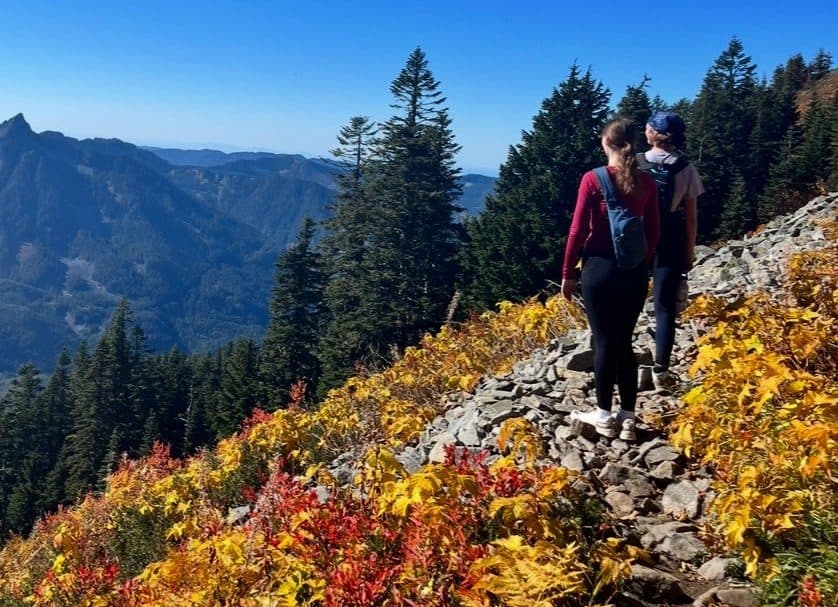IN THE SPRING of 2019, second grade teacher Jennie Warmouth sat on the floor with her Spruce Elementary School students, each proudly wearing a polar bear hat. Hands waved in the air as the students peppered her with questions.
“Will you sleep in an igloo?” “Where is the Arctic?” “Will you freeze in the water if you fall in?” “Are there lots of polar bears?”
Warmouth was soon to leave for the Svalbard Islands in the Arctic as a National Geographic Grosvenor Teacher Fellow. Her schoolkids in Lynnwood, Washington, would follow along through a website Warmouth created. She reassured them she’d be safe on the ship, and she would send pictures and
answer the questions students emailed to her. She hoped to connect the kids to a remote and fragile part of the world — and, as an empathy researcher who studies the motivations and thoughts behind behavior, she also hoped her students would feel a heart connection to the Arctic animals, the environment, and the greater world they belong to.
Warmouth spent 11 days on the ship.

“I hadn’t felt this kind of wonder since I was a child myself,” she said. “The ecosystem was so barren, so pristine, soaked in bright light. I felt tiny in such a vast place, but privileged and indebted at the same time to protect it.”
She hardly slept, spending her days scanning for wildlife and uploading photos to the trip website for the kids to see. Once the children felt satisfied their teacher was safe, they began to ask about the animals, the sea creatures, the snow, the landscape. They sent Warmouth hundreds of questions, becoming experts on a distant place they’d previously never heard of.
“It’s important not to create empathetic stress for kids, overwhelming them with issues they can’t do anything about.” — JENNIE WARMOUTH
When Warmouth returned to school, a new fall class of students awaited. These kids had also heard of her trip, and she wanted their curiosity to guide the discussion.
“On the ship we performed a plankton tow to see if the Arctic waters contained microplastic [tiny plastic fragments that are in the environment and oceans],” Warmouth said. “Instead, we discovered large macro-plastic all over the shoreline. I presented this new group of students with a mystery — how did plastic trash wind up in a place where no people live?”

When she showed the students a photo of a gloved hand holding pieces of garbage, the students immediately resonated with the most familiar image in the photograph: a plastic ice cream spoon. It reminded them of the sporks that came in their breakfast and lunch trays at school. Their curiosity led to studies about ocean currents and the impact of plastics on the Arctic animals.
Warmouth wrote her doctoral dissertation on the interactions between animals and children and the empathetic response those relationships generate. She also published a recent Journal of Ecotourism article about how encounters with wildlife, or “environmental epiphanies,” produce empathy in adults, which can lead to conservation behaviors. Just like the adults in her research, Warmouth’s schoolkids began to experience empathy for the polar bears and grow uneasy about their own part in endangering them.
“It’s important not to create empathetic stress for kids,” Warmouth said, “overwhelming them with issues they can’t do anything about.” Instead, she guided the students to discussions of what they might do about the use of plastic sporks at the school — 72,000 per year, the kids discovered.
They reflected on how they often threw away the sporks without even using them. The kids mobilized. They mustered their courage and presented their findings to the school administrators, who agreed to switch to metal silverware but asked the students to solve the problem of their peers throwing
away metal implements. The Silverware Patrol was born.
Warmouth bought green vests and magnetic wands to retrieve discarded silverware. Seventy students applied to become officers stationed at the cafeteria garbage cans, and Warmouth’s second graders reviewed the patrol application essays. Students began educating each other about plastic waste and the impact on the environment. The kids sacrificed time and convenience, faced fears about exercising authority over their peers, and discovered new talents and strengths. Through Warmouth’s dedication to student-generated learning, a new crop of kids experienced empathy and turned it into advocacy.
In the fall of 2020, Warmouth welcomed a new class of second graders, this time in a virtual school format because of the pandemic. These kids were further removed from her Arctic journey but were still intrigued by polar bears. Warmouth again followed the students’ curiosity, which led to discussions about brown bears native to the Pacific Northwest.
Warmouth serves as a board member at the Progressive Animal Welfare Society (PAWS) in Lynnwood, close to her school, so she took the kids to the center to learn about three baby brown bears who’d recently lost their mothers. Again, she engaged the students’ empathy: What lessons do baby bears normally learn from their moms? Could the students fill the role of mother bear, designing something that would help the cubs learn the lessons they need to return to the wild?
The kids designed an educational bear toy — natural fiber piñatas containing seeds and berries — that the baby bears learn to scratch open. When the students finish building and delivering the piñatas, PAWS will provide the class with videos of the young bears learning to open the piñatas for food. This year, Warmouth’s students wear brown bear hats.
Keeping students engaged has been a challenge during the pandemic. Warmouth decided to build upon the students’ brown bear fascination. She approached Seattle’s Brown Bear Car Wash in Seattle and asked if the company would donate money to PAWS for the bear cubs, funds students could “unlock” by reading books. In two days, Spruce Elementary students read 2,615 books and raised $2,000 for their three local bears.

In addition to teaching second grade, Warmouth is an adjunct professor at SPU, teaching a course for educators on reading strategies. She’s an advocate for project-based learning and guiding students in real-world issues of importance to them. Fifteen years ago, she designed a curriculum for students to write online advertisements for hard-to-place pets.
“I believe in writing with a purpose and writing anchored in truth,” Warmouth said. “Some of the kids have suffered neglect and abuse. They could empathize with a dog or cat who showed behavior problems. The kids felt good about advocating for these animals. We want to give students a voice about what’s important to them and provide a pathway to action, not simply talk about abstract concepts,” Warmouth said.
Though she’s passionate herself about the natural world, she wants kids to discover what they’re passionate about. “They may never travel to the Arctic as I did, but how can we help them get in touch with what matters to them?”




